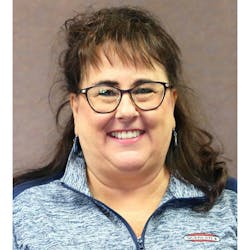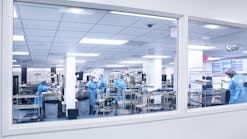What is the best approach - reprocessing surgical instruments on-site in each hospital or surgery center, in a centralized location within a health system that serves all of its surgery sites, or in an off-site facility away from the point of care?
Over the years, Healthcare Purchasing News has explored the pros and cons of each approach, the last time being June 2020 as hospitals and surgery centers struggled with COVID-19-related elective surgery delays and cancellations. At that time, HPN asked the question: Will the pandemic change where and how instruments are processed?
Based on insights from Central Service/Sterile Processing & Distribution (CS/SPD) department professionals, product and service providers, and others in the industry, it seems COVID-19 has driven some changes in reprocessing practices, but there are other factors at hand that have influenced where reprocessing takes place even more.
COVID-driven changes
“This is a common occurrence and can create delays in endoscope availability,” he stated. “Most other healthcare facilities that I am familiar with are not making any major changes related to reprocessing in the midst of the pandemic.”
While she has not seen specific shifts to off-site reprocessing due to COVID-19, Sharon Greene-Golden, BA, CRCST, CER, SME, FCS, oneSOURCE consultant and Manager, Adventist Health Care Shady Grove Medical Center, says some hospitals have altered course, driven by the pandemic.
“Hospitals may have made some changes in their processes due to having to close one institution and still have instruments available, but the process would only change in the pick-up and delivery of said instruments,” noted Greene-Golden.
“We were fortunate to continue working as a normal sterile processing department due to the need of our services throughout the hospital,” she added. “We still had the Cath lab, Labor & Delivery, Cancer Center and the Emergency Department using instruments that needed to be processed daily. Each hospital in our healthcare system was able to maintain complete processing control during this pandemic.”
What drives introspection?
As COVID-19 has impacted the volume of surgical procedures, with hospitals intermittently delaying elective surgeries when faced with surges in SARS-CoV-2 virus patients, many CS/SPD teams have taken the opportunity to evaluate their operations.
Kathy Shepherd, Senior Inside Sales Representative, Scanlan, says a number of her company’s partners have taken the opportunity to review their strategies and processes this year.
When COVID-19 hit the U.S. in early 2020, some hospitals chose to put on hold any plans for reprocessing changes, but in 2021 there appears to be a renewed desire for advancement, explains John Kimsey, Vice President of Operations, STERIS Instrument Processing Solutions.
“COVID’s impact in 2020 caused hospitals to pause on any strategic decision making concerning off-site reprocessing. Those interested in moving towards off-site reprocessing maintained their interest but were forced to fully shift focus to the pandemic. As hospitals are returning to the new normal operations, the interest in off-site reprocessing and/or centralized reprocessing is returning. Overall, STERIS hasn’t seen the pandemic changing the way instruments are processed but rather only delayed hospitals’ planned changes.”
One health system that has taken a proactive approach to reprocessing changes is Ohio State University Wexner Medical Center. According to Kimberly Jones, BA, CRCST, Director of Central Sterile Supply, Main Campus, they opened an off-site processing facility in February 2021 to help address the capacity needs and meet the demands and future needs of the health system (see sidebar, below).
Single-use device reprocessing
“Since summer 2020, we have seen an uptick in hospitals that want to use reprocessed single-use devices – and a significant increase in volume from our existing hospital partners,” Thording stated. “I attribute this to two things. First, since the personal protective equipment (PPE) shortage, hospital staff have developed a new mindset about reuse. They are thinking twice before throwing away a used device. Second, the financial hit to hospitals from the pandemic has increased the level of importance associated with cost savings. Single-use device reprocessing reduces costs without adding risk and ultimately equips financially strained hospitals to provide better patient care.”
Don’t make it all or nothing
Rather than keeping CS/SPD operations on-site at each hospital, or moving everything off-site to a separate facility, many healthcare organizations continue to consolidate reprocessing to a single hospital within their network.
“Within the Chicago market, we have not seen any dramatic change in reprocessing strategies. However, we have all seen several large integrated delivery networks (IDNs) move to a centralized reprocessing approach (e.g., UPenn, University of Iowa),” said Jodi L. Eisenberg, Chief Quality Officer, Vested Medical. “What is important to consider is the misconception that it’s an all or nothing decision. What might be more appropriate is to think about the optimal approach for each type of surgery and to have an option to select either an on-site or an off-site alternative, depending on the criteria. Additionally, while it might be possible for a large IDN to invest $80 million in an off-site reprocessing center, how realistic is it for the community-based healthcare facilities and the stand-alone ASC that need options?”
Eisenberg says she has seen some health systems keep most reprocessing on-site, while leveraging an off-site facility as a “pressure-relief strategy for the most challenging surgeries.”
“Two examples are total hip arthroplasty (THA) and total knee arthroplasty (TKA) that rely heavily on loaner trays and are very challenging for most sterile processing teams,” she said. “Off-loading these surgeries provides immediate relief for SPD staff but also provides a contingency when it makes sense to sterilize on-site.”
Dr. Garrett has seen movement towards centralization for a variety of reasons, most notably standardization of reprocessing, reduced costs and the ability to preserve valuable real estate.
“There are some disadvantages as well from potential delays in device availability,” he said. “The FDA has also recommended eliminating the reprocessing process for high-risk procedures, such as endoscopic retrograde cholangiopancreatography (ERCP) due to the potential risk for healthcare-associated infections. This can most easily be accomplished by utilizing disposable duodenoscopes.”
Impact on ambulatory surgery
It is not just hospitals that have suffered revenue loss from a downturn in elective surgery volumes, ambulatory surgery centers (ASCs) have been equally if not more challenged, notes Vested’s Eisenberg.
The impact of COVID-19 pandemic is being felt in all areas of healthcare,” said Eisenberg. “Over the past year, we have seen a halt to elective surgeries, which meant a decrease in volumes for both acute settings as well as ambulatory settings. As we stabilize the pandemics effects, healthcare organizations are looking to ways to ramp up the revenue streams. Add to this the recent payor changes to the rules for reimbursement on the ambulatory side, the opportunities are ripe to increase ambulatory surgery volume.”
But a sharp increase in ASC procedure volumes poses challenges to on-site reprocessing, according to Eisenberg, prompting some to consider a switch to off-site/outsourced CS/SPD operations.
“Unfortunately, many of these ASCs do not have the capacity nor a sufficient team of properly trained sterile processing staff,” she said. “Some of the surgeries that are being pushed to the ambulatory setting include orthopedics. These elective surgeries require the use of complex surgical instrumentation and implants, which are delivered in the form of loaner trays, in most cases, less than 24 hours prior to the surgery. Space, capacity and staffing in the current ASC model don’t appropriately support this care. This is where off-site reprocessing gains more support because, like many other hospital services, there are benefits to outsourcing this activity to a more production-oriented, quality-focused partner.”
Reasons for reprocessing shifts
Whether a healthcare organization is revamping its on-site CS/SPD operations, centralizing them to a single hospital or moving everything to an off-site facility, the decision takes careful consideration, and the process can be both complex and challenging. Here is advice from those who have experience doing it.
“My biggest piece of advice is to consider the pre-work and preparation involved,” said Ash Crowe, MHA, Project Manager, St. Onge Company. “Going off-site is a huge culture shift that requires good communication, standard practices and collaboration between sterile processing and operating room (OR) leadership. Any cracks in communication or processes that exist now will become much bigger issues if not addressed prior to going off-site.”
OSU Wexner’s Jones agrees. “Addressing the communication issues was key in the success of planning a facility that provides a sterile and quality product for our clinical partners and most importantly our patients,” she added.
Kimsey notes how the movement of operations “as is” to a centralized or off-site model will only compound any current operational issues the organization is experiencing.
“Centralizing or utilizing an off-site reprocessing center provides the perfect catalyst for a process improvement program to address operational issues, such as missing instruments, point of use cleaning and returning instruments to the correct trays post procedure, SPD compliance to instructions for use (IFU), staff education, proper staffing levels, and capacity restraints,” he commented. “Take this strategic decision as your opportunity to address the root cause of your current operational issues before you move off-site or centralize.”
Before making a shift to centralization, Dr. Garrett recommends the organization conduct a time-in-motion study to determine if there is truly a cost or procedural time savings that will result from centralization.
“Many times, the perceived benefits are outweighed by risks and/or delays in instrument availability,” he said. “You must also consider transportation of the soiled devices to ensure compliance with hazardous medical waste transportation regulations. Finally, are the personnel that will be reprocessing the devices in the central locations properly trained in reprocessing the devices.”
According to Eisenberg, making the decision to keep sterile processing on-site or not relies mostly on quality, efficiency and cost aspects.
“Talk to those who have done it to evaluate what worked and what didn’t work,” Eisenberg advised. “Strongly consider working with a partner who offers a collaborative approach to outsourcing and the opportunity to start in a focused way with the opportunity to expand as data and results warrant. Establish clear channels of communication with vendor partners. These partners need to understand and determine what is considered urgent versus what is elective. There must be visibility into the logistics and planning to all stakeholders. A major consideration for all should be on the use and efficient processing of loaner equipment.”
For those organizations considering a transition to off-site reprocessing, Sutton suggests they do the following:
- Talk to people who have already done it.Find reliable partners with recent, relevant, experience, including:
- Equipment vendors
- Real estate developers
- Instrument tracking suppliers.
- Designate an internal project team that includes key players from almost every part of the organization to assist with the investigation.
- Start the study with an end goal in mind. The team must have a clear picture of where the health system is headed in the next five to 10 years. Also, any major upgrades to existing CS/SPD departments should be suspended until the study is complete.
- Create a transition and implementation plan while the building is being constructed or up-fitted.
The future of reprocessing
COVID-19 came out of nowhere and devastated the U.S. healthcare industry. Nobody knows what the future may hold but based on current trends, healthcare organizations must take steps to improve the sustainability of their reprocessing operations. Many see the trend toward consolidated and off-site reprocessing growing in the years ahead.
“I am optimistic that COVID-19 has taught us many valuable lessons as a healthcare industry, one of which is that a constant vigilance to infection prevention and control is necessary to reduce patient harm and also ensure the safety of reprocessing personnel,” said Dr. Garrett. “Healthcare has certainly faced many challenges over the past decades, but none with the long-lasting impacts associated with the COVID-19 pandemic. Healthcare systems and providers must adapt and overcome, particularly as it relates to staff resiliency and also pandemic preparedness.”
“Reprocessing as a whole must evolve to protect both the patient AND the reprocessing personnel, especially when potentially dangerous pathogens may be aerosolized into the air following aerosol-generating procedures and reprocessing,” he added.
“While STERIS hasn’t seen significant changes in reprocessing strategies, we are continuing to see a slow but steady trend towards consolidation and off-site reprocessing,” noted Kimsey. “These moves are long-term strategies by healthcare systems to address infrastructure issues as well as operational and clinical best practices while planning for future growth and requirements. We anticipate this steady trend will continue for the foreseeable future.”
“The best practices our partners have been sharing with us are the importance of having a solid and flexible approach to any changes, exploring the possible unintended consequences of any changes and setting clear expectations both internally and externally with any teams affected by changes to workflow processes,” said Scanlan’s Shepherd.
“We are witnessing the beginning of a shift that focuses more on quality, efficiency and standardization,” Eisenberg explained. “In the next five to 10 years, I believe off-site will be a standard in the industry. Once you unlock the value of off-site reprocessing, it is hard to imagine going back to a less optimal solution. Instead, what is likely to happen is more and more innovation will come into the solution space. Companies that today work on only one part of the problem, such as technology or logistics, will join together to provide seamless, end-to-end solutions that continue to evolve and develop.”
Communication, collaboration key to OSU Wexner off-site reprocessing success
In 2017, Ohio State University Wexner Medical Center (OSU) examined the growth plan across its enterprise for surgical volume and determined that given the current footprint of Central Sterile Supply (CSS) across the enterprise, building a freestanding CSS hub was the most strategic financial solution for the organization.
In planning the facility, CSS team members played an integral role in the facility design, which features abundant natural light and evolutionary state-of-the-art equipment. From a growth perspective, the building was designed to accommodate the current state surgical volume, as well as the future state of surgical services through the year 2027. OSU opened its new off-site CSS in February 2021.
“Operational preparation and collaboration with our operating room (OR) partners could not be understated,” said Kimberly Jones, BA, CRCST, Director of Central Sterile Supply, Main Campus, OSU. “We worked tirelessly with our clinical partners to examine current processes involving OR and CSS. Ultimately, we collectively reevaluated current practices and made modifications preemptively to accommodate the off-site facility. Additionally, we involved our surgeons early on to obtain the necessary buy-in and support to go live with new workflows.”
“Some of the lessons learned within the first 30 days after opening the facility relate to communication, follow through and continued partnership with our subject matter experts,” Jones added. “Having had a successful relationship with theses partners prior to go live has enabled open communication when processes need to be modified.”












